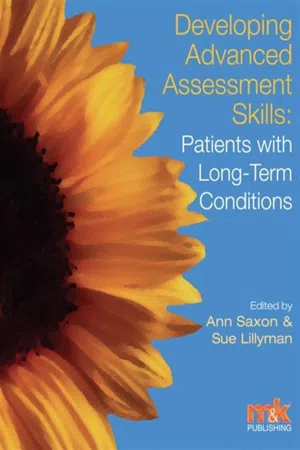![]()
Chapter 1
Developing competence and skills in the care of long-term conditions
Ann Saxon and Sue Lillyman
Key areas
Meeting patient needs and models of care
Self-assessment of strengths and weaknesses
Reflective journals and learning contracts
Resources and developing skills
Introduction
It is estimated that 17.5 million people in the UK report living with a longterm condition (Department of Health, 2005). As we live longer, with better medical provision and living conditions, this is expected to rise to 18 million by 2025 (Department of Health, 2008) in people aged over 65 in England. It is currently around 15 million for this age group. Our ageing society has also been affected by the baby-boom generation of the post-war era and increased life expectancy. The Department of Health (2008) stated that:
Long-term conditions are those conditions that cannot, at present, be cured, but can be controlled by medication and other therapies. The life of a person with a long-term condition is forever altered – there is no return to normal.
Common conditions include:
• Coronary heart disease, heart failure, stroke, transient ischaemic attacks and hypertension.
• Diabetes.
• Chronic obstructive pulmonary disease and asthma.
• Epilepsy.
• Cancer.
• Chronic kidney disease.
• Multiple sclerosis and motor neuron disease, Parkinson’s disease, dementia, schizophrenia and depression.
Exercise 1.1
List the most common conditions your patients present with.
How does your list compare with above list?
Meeting the needs of people with long-term conditions
People may be at risk of developing a long-term condition or chronic illness due to a variety of factors. First there is genetic makeup, for example some people are susceptible to motor neuron disease or certain types of cancer. And it could be the result of lifestyle. For example, people who are obese could develop diabetes and people who smoke could develop chronic obstructive pulmonary disease. However, genetic make-up and lifestyle are not the only factors. Many causes remain unknown.
Once people are diagnosed with a long-term condition then care must be provided and coordinated to help the person live with that condition. The UK Government (Department of Health, 2005; cited by Baines, 2008) identified that the care needs of patients with long-term conditions should be divided into three levels:
Level 1: This is aimed at encouraging people to self-manage and self-care. They estimated that 70–80 per cent of this patient group would be in this category.
Level 2: Level 2 involves the support of a multidisciplinary team (MDT) approach and includes people with single or multiple conditions. These patients are at risk of complications of their conditions and require some proactive management.
Level 3: Level 3 targets those patients with highly complex and/or multiple conditions who have had frequent unplanned admissions to hospital for exacerbations of their condition.
Generic model for long-term conditions
The Department of Health (2011) outlined four aspects of care to support patients with long-term conditions. This model suggests the following interventions:
• Case management.
• Personalised care planning.
• Supporting self-care.
• Assistive technology.
These are also in line with the document entitled Liberating the NHS (Department of Health, 2010). Case management is the cornerstone of effective care and for the purpose of this book the roles of the community matron and case manager are therefore synonymous.
This book will enable you to further develop your assessment skills for patients living with a long-term condition and it will assist your understanding of the interventions and what they may mean for you and your team. In order to start reviewing your development you may want to commence with a self-assessment or reflection on your current job or role.
Self-assessing your strengths and weaknesses
Identifying our own strengths and weaknesses can be pretty daunting. We are often only required to consider this when we are attending a formal course or undergoing a job appraisal. However, it can be beneficial to your development to carry this out on a regular basis using some of the tools noted below. In developing a portfolio of skills it is vital that you are able to provide evidence of how you have achieved competence in a specific area.
For further information, you may want to review the following link:
http://www.dh.gov.uk/en/Publicationsandstatistics/Publications/
PublicationsPolicyAndGuidance/DH_4133997.
In 2006, the Department of Health identified an education framework for use by community matrons and case managers. It set out a range of skills and competencies required of the role. The competency tool has nine domains and ten principles. It was envisaged that these competencies would also help to develop personal effectiveness when caring for patients with a long-term condition. Here are the nine domains it outlines:
• Advanced clinical nursing practice.
• Leading complex care coordination.
• Proactive management of complex long-term conditions.
• Management of cognitive impairment and mental well-being.
• Supporting self-care, self-management and enabling independence.
• Providing professional practice and leadership.
• Identifying high-risk patients, promoting health and preventing ill health.
• Managing care at the end of life.
• Interagency and partnership working.
Here are the ten underpinning principles of these domains:
• Advanced practice.
• Learning methods.
• Recognising prior learning.
• Inter-professional learning.
• Mentorship and coaching.
• Organisational governance.
• Collaborative commissioning.
• Assessment of competencies.
• Clinical supervision and continuing professional development.
• Supporting experienced hospital nurses to move into community matron roles.
The framework was based on the principle that, wherever possible, learning should take place in the workplace. This is more likely to encourage learning in everyday practice.
The National Health Service Knowledge and Skills Framework (Department of Health, 2004) has also enabled individuals to assess their own level of competence in other areas. Your own job description will include a range of competencies from the framework and you may be working towards achieving these in relation to caring for patients with a long-term condition.
Fifty-three competencies relating to case management have been developed by the NHS Skills for Health (www.skillsforhealth.org.uk). They include the National Workforce Competencies and the National Occupational Standards for long-term conditions.
A list of the competencies can be found at:
https://tools.skillsforhealth.org.uk/tools.
The range of competencies could be reviewed against your own role in caring for patients with long-term conditions and help you to construct a development plan for the future. Here are examples of just a few of them:
• Obtain information to inform the assessment of an individual.
• Investigate and diagnose an unwell individual as part of clinical management of the long-term condition.
• Enabl...




